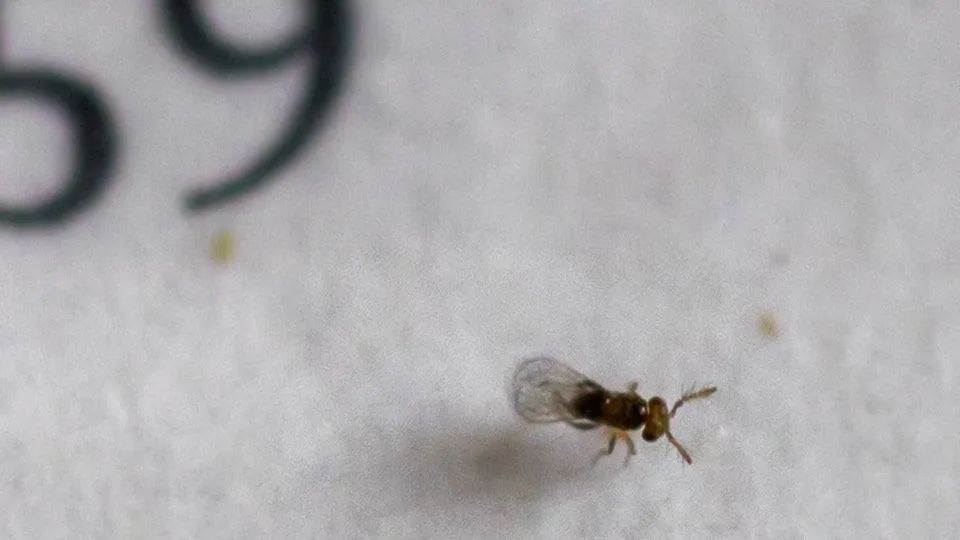Historic British Mansion Fights Moths With Tiny Parasitic Wasps
The moths eat wool and silk, putting historic artifacts—like a tapestry gifted to the house by Catherine the Great—at risk
/https://tf-cmsv2-smithsonianmag-media.s3.amazonaws.com/filer/91/0c/910c6814-99b1-48dd-a6b0-deaf7fb42b38/gettyimages-676992352.jpg)
The historic Blickling Hall in Norfolk, England, is employing a crack team of microscopic wasps to defeat a moth infestation.
As pandemic-related restrictions have kept visitors largely away from the National Trust of the United Kingdom’s historic properties, the houses have seen a three percent rise in common clothes moths and an 11 percent rise in insect pests overall. Clothes moths threaten to damage the elaborate wool and silk décor, much of it centuries-old. Since noticing damage to a wool carpet in Blickling Hall’s State Bedroom, the National Trust has partnered with the company Historyonics to use a unique combination of pest control measures against the moths.
“It’s not like our tapestries are falling off the wall and our things are being munched to bits,” says National Trust assistant national conservator Hilary Jarvis to the New York Times’ Anna Schaverien. “It’s just that no damage is acceptable and it’s heartbreaking when you do find something.”
Historyonics will place small card dispensers, each containing about 2,400 Trichogramma evanescens wasps, in 11 rooms around the mansion, according to a statement. The species of wasp is not a threat to humans, and can’t sting like their better-known cousins. Each insect is only a half-millimeter long when fully grown, making it nearly microscopic.

The tiny wasps provide pest control because they lay their eggs inside of common moth eggs. The wasp larva eats the moth egg from the inside, and a wasp hatches. Over time, the Trust hopes that the parasitic wasps could wipe out the moth eggs and stop their population from growing.
The wasps need to catch the moth eggs early, or else after a few weeks, they’ll hatch into larvae that spend months munching on natural fibers. Eventually, the larvae build cocoons and grow into adult moths, which can’t eat and don’t cause any additional damage—except to lay more eggs and continue the cycle.
“We know they’re there and we’re not going to be complacent,” says Jarvis to the New York Times. “I can’t take the risk that we let those moths thrive.”
Blickling Hall is listed in Britain’s earliest public record, the Domesday Book, which was written in the 11th century, Rob Picheta reports for CNN. The house was at one point the home of Geoffrey Boleyn, grandfather of Anne Boleyn, who may have been born there around 1507.
Her daughter, Elizabeth I would become Queen of England and Ireland, but Anne didn’t live to see it—King Henry VIII had Anne Boleyn executed in 1536. Now, the house holds one of only two surviving pieces of Queen Anne’s throne canopy, as well as one of the most complete examples of an 18th-century ambassadorial canopy and headcloth set, reports BBC News.
Blickling Hall also has on display a tapestry of Peter the Great of Russia, that was gifted to John Hobart, Second Earl of Buckinghamshire by Russia’s Catherine the Great in the 1760s.
While the lack of foot traffic amid the Covid-19 pandemic may have given the moths room to grow, the Trust also cites the U.K.’s mild winter as a factor in the pests’ rising population. To assist the wasps in their efforts, the pest control company Historyonics will also spray moth pheromones to confuse male moths and reduce the number of eggs in the next mating season.
The National Trust staff anticipate that the it may take until autumn to complete testing of the combined pheromone-wasp pest-tactic, and then until next spring or summer to wrap up the process. According to the statement, once the wasps are finished their job, they will “die naturally and disappear inconspicuously into house dust.”